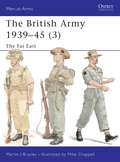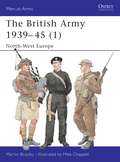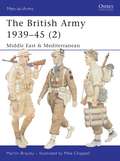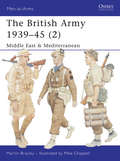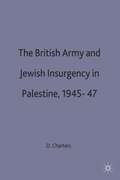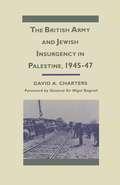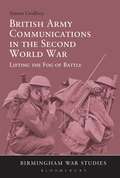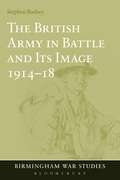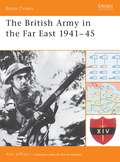- Table View
- List View
The British Army: A New Short History
by Ian F. BeckettThe story of the British army, from its inception in the late seventeenth century to the present. This new concise history by one of Britain's leading military historians explores the British army from the creation of a permanent standing army in the seventeenth century to the present. It sets the institutional development of the British army, and its often ambiguous relationship with state and society, as well as the army's wider political, social, economic, and cultural role within international, imperial, national, regional, and local contexts. An army exists to fight, however, and the British army's story cannot be separated from those wars and conflicts that have punctuated its evolution. Consequently, attention is also paid to the army's commanders, operations, and battlefields from the Wars of the Three Kingdoms in the seventeenth century to Iraq and Afghanistan in the twenty-first. Beckett traces the army's evolution through five chronological phases: the standing army of the seventeenth century and its antecedents, the national army of the eighteenth century, the imperial army of the nineteenth century, the people's army of the two world wars, the era of national service, and the return to a small professional army fulfilling a global role envisaged by successive governments in the twenty-first century at a time of rapidly changing social attitudes towards the utility of force, that pose a challenge to the army's traditional core values.
The British Army: A New Short History
by Ian F. BeckettThe story of the British army, from its inception in the late seventeenth century to the present. This new concise history by one of Britain's leading military historians explores the British army from the creation of a permanent standing army in the seventeenth century to the present. It sets the institutional development of the British army, and its often ambiguous relationship with state and society, as well as the army's wider political, social, economic, and cultural role within international, imperial, national, regional, and local contexts. An army exists to fight, however, and the British army's story cannot be separated from those wars and conflicts that have punctuated its evolution. Consequently, attention is also paid to the army's commanders, operations, and battlefields from the Wars of the Three Kingdoms in the seventeenth century to Iraq and Afghanistan in the twenty-first. Beckett traces the army's evolution through five chronological phases: the standing army of the seventeenth century and its antecedents, the national army of the eighteenth century, the imperial army of the nineteenth century, the people's army of the two world wars, the era of national service, and the return to a small professional army fulfilling a global role envisaged by successive governments in the twenty-first century at a time of rapidly changing social attitudes towards the utility of force, that pose a challenge to the army's traditional core values.
The British Army 1815-1914
by Harold E. RaughThis collection of essays examines the evolution of the British Army during the century-long Pax Britannica, from the time Wellington considered its soldiers 'the scum of the earth' to the height of the imperial epoch, when they were highly-respected 'soldiers of the Queen'. The British Army during this period was a microcosm and reflection of the larger British society. As a result, this study of the British Army focuses on its character and composition, its officers and men, efforts to improve its efficiency and effectiveness and its role and performance on active service while an instrument of British Government policy.
The British Army 1815-1914
by Harold E. Raugh JrThis collection of essays examines the evolution of the British Army during the century-long Pax Britannica, from the time Wellington considered its soldiers 'the scum of the earth' to the height of the imperial epoch, when they were highly-respected 'soldiers of the Queen'. The British Army during this period was a microcosm and reflection of the larger British society. As a result, this study of the British Army focuses on its character and composition, its officers and men, efforts to improve its efficiency and effectiveness and its role and performance on active service while an instrument of British Government policy.
The British Army 1914-1918
by Andrew RawsonAn indispensable guide to the British Army during the First World War covers the men who fought for Britain: from the ‘Old Contemptibles’ – the professionals who stemmed the German advance at the beginning of the war – to the Territorials, the ‘Derby Men’, Kitchener’s ‘New Army’ and the conscripts who eventually defeated the Kaiser’s armies four years later. Andrew Rawson examines the impressive contributions made by the Dominions and the Empire and explores aspects of doctrine, training, communications, strategy and tactics, together with divisional organisations, histories and the roles of the different Arms and Services. He reviews all aspects of the soldier’s everyday life – uniforms, equipment, rations, trench life, leave and military discipline – and profiles the commanders and the legacy of the war in art, as well as providing information on cemeteries and places of interest. It is all here, in one book.
The British Army 1939–45: The Far East (Men-at-Arms)
by Mike Chappell Martin BrayleyThe lightning Japanese offensives in the Far East in 1941/42 inflicted a series of costly defeats on the ill-prepared and badly supported British Commonwealth forces in Malaya and Burma. The 'forgotten' 14th Army on the India-Burma border slowly built up its strength and its tactical expertise; and Wingate's 'Chindits' proved that units supplied from the air could operate deep behind enemy lines. In 1944 General Slim's troops decisively smashed Japan's last offensive at Imphal and Kohima; and over the next year they drove the enemy relentlessly back through Burma, reducing them to starving fugitives by the final victory in August 1945. This concise summary of Britain's Far East campaigns is illustrated with many rare photographs, and eight detailed colour plates.
The British Army 1939–45: North-West Europe (Men-at-Arms)
by Mike Chappell Martin BrayleyThe Second World War was Britain's last conflict as a world power. For a year it saw Britain standing alone against the fascist dictatorships; winning it demanded the sacrifice of the entire national wealth. This first book of three describes the uniforms developed for European service. It traces the appearance of the 'Tommy' from pre-war mobilization, through the years of defeat and endurance, to D-Day and the long fighting advance to Northern Germany. The book also includes a campaign summary, infantry organization tables, lists of arms and services and basic specifications of a number of heavy weapons.
The British Army 1939–45: Middle East & Mediterranean (Men-at-Arms)
by Mike Chappell Martin BrayleyThe scope of Britain's wartime Middle East Command stretched far beyond the Libyan desert where the 8th Army's most famous battles were fought from Gibraltar and Tunisia in the west, to Iraq and Persia in the east, and from Greece south to the Gulf of Aden. In 1940-43 this was the only arena where the British Army could take the ground war to the German Wehrmacht; it saw a succession of setbacks and triumphs, until spring 1945 found the 8th Army victorious in northern Italy. A summary of these campaigns is illustrated by photographs, and detailed colour plates of the wide range of uniforms worn in the varied conditions of this huge theatre of war.
The British Army 1939–45: North-West Europe (Men-at-Arms)
by Mike Chappell Martin BrayleyThe Second World War was Britain's last conflict as a world power. For a year it saw Britain standing alone against the fascist dictatorships; winning it demanded the sacrifice of the entire national wealth. This first book of three describes the uniforms developed for European service. It traces the appearance of the 'Tommy' from pre-war mobilization, through the years of defeat and endurance, to D-Day and the long fighting advance to Northern Germany. The book also includes a campaign summary, infantry organization tables, lists of arms and services and basic specifications of a number of heavy weapons.
The British Army 1939–45: The Far East (Men-at-Arms #375)
by Mike Chappell Martin BrayleyThe lightning Japanese offensives in the Far East in 1941/42 inflicted a series of costly defeats on the ill-prepared and badly supported British Commonwealth forces in Malaya and Burma. The 'forgotten' 14th Army on the India-Burma border slowly built up its strength and its tactical expertise; and Wingate's 'Chindits' proved that units supplied from the air could operate deep behind enemy lines. In 1944 General Slim's troops decisively smashed Japan's last offensive at Imphal and Kohima; and over the next year they drove the enemy relentlessly back through Burma, reducing them to starving fugitives by the final victory in August 1945. This concise summary of Britain's Far East campaigns is illustrated with many rare photographs, and eight detailed colour plates.
The British Army 1939–45: Middle East & Mediterranean (Men-at-Arms #368)
by Mike Chappell Martin BrayleyThe scope of Britain's wartime Middle East Command stretched far beyond the Libyan desert where the 8th Army's most famous battles were fought from Gibraltar and Tunisia in the west, to Iraq and Persia in the east, and from Greece south to the Gulf of Aden. In 1940-43 this was the only arena where the British Army could take the ground war to the German Wehrmacht; it saw a succession of setbacks and triumphs, until spring 1945 found the 8th Army victorious in northern Italy. A summary of these campaigns is illustrated by photographs, and detailed colour plates of the wide range of uniforms worn in the varied conditions of this huge theatre of war.
British Army and Jewish Insurgency in Palestine, 1945-47: Studies in Military and Strategic History (PDF)
by David A. ChartersThe first comprehensive scholarly study of the British Army's campaign against the Jewish insurgency in postwar Palestine, this book shows how outdated doctrine, traditional resistance to change, and postwar turbulence hampered the army's efforts to modify its counter-insurgency tactics. It also shows why the security forces failed to develop intelligence sufficient to defeat the insurgents.
The British Army and Jewish Insurgency in Palestine, 1945-47 (Studies in Military and Strategic History)
by David A. ChartersThe first comprehensive scholarly study of the British Army's campaign against the Jewish insurgency in postwar Palestine, this book shows how outdated doctrine, traditional resistance to change, and postwar turbulence hampered the army's efforts to modify its counter-insurgency tactics. It also shows why the security forces failed to develop intelligence sufficient to defeat the insurgents.
British Army Communications in the Second World War: Lifting the Fog of Battle (Birmingham War Studies)
by Simon GodfreyCommand, Control, Communications and Intelligence form the backbone of the Army's operating system. But while much attention has been given in the literature to the other three elements, Communications in the British Army during World War II have been widely ignored. This book rectifies the omission. It shows that failures in front line communications contributed to several of the set backs suffered by the Army but also that ultimate victory was only achieved after a successful communications system was in place. It explains how the outcome of the main campaigns in Europe and North Africa depended on communications, how the system operated and how it evolved from a relatively primitive and inadequately supplied state at Dunkirk to a generally effective system at the time of the Rhine crossings. Problems still occurred however, for example at infantry platoon level and famously with paratrooper communications at Arnhem, often simply due to the shortcomings of existing technology. The book concludes that it is only very recently that advances in technology have allowed those problems to be solved.
British Army Communications in the Second World War: Lifting the Fog of Battle (Birmingham War Studies)
by Simon GodfreyCommand, Control, Communications and Intelligence form the backbone of the Army's operating system. But while much attention has been given in the literature to the other three elements, Communications in the British Army during World War II have been widely ignored. This book rectifies the omission. It shows that failures in front line communications contributed to several of the set backs suffered by the Army but also that ultimate victory was only achieved after a successful communications system was in place. It explains how the outcome of the main campaigns in Europe and North Africa depended on communications, how the system operated and how it evolved from a relatively primitive and inadequately supplied state at Dunkirk to a generally effective system at the time of the Rhine crossings. Problems still occurred however, for example at infantry platoon level and famously with paratrooper communications at Arnhem, often simply due to the shortcomings of existing technology. The book concludes that it is only very recently that advances in technology have allowed those problems to be solved.
The British Army in Afghanistan 2006–14: Task Force Helmand (Elite)
by Peter Dennis Leigh NevilleFighting an elusive and dangerous enemy far from home, the British army in Afghanistan has been involved in asymmetric warfare for the best part of a decade. The eight-year series of deployments jointly known as Operation Herrick, alongside US and other NATO contingents within the International Security Assistance Force (ISAF) in Afghanistan, have been the longest continuous combat commitment of the British Army since World War II. Together with Operation 'Telic' in Iraq, which immediately preceded and overlapped with it, this conflict has shaped the British Army for a generation. Enemy threats have diversified and evolved, with a consequent evolution of British doctrine, tactics and equipment. This book provides a detailed analysis of those specifics within a clear, connected account of the course of the war in Helmand, operation by operation.
The British Army in Afghanistan 2006–14: Task Force Helmand (Elite)
by Leigh NevilleFighting an elusive and dangerous enemy far from home, the British army in Afghanistan has been involved in asymmetric warfare for the best part of a decade. The eight-year series of deployments jointly known as Operation Herrick, alongside US and other NATO contingents within the International Security Assistance Force (ISAF) in Afghanistan, have been the longest continuous combat commitment of the British Army since World War II. Together with Operation 'Telic' in Iraq, which immediately preceded and overlapped with it, this conflict has shaped the British Army for a generation. Enemy threats have diversified and evolved, with a consequent evolution of British doctrine, tactics and equipment. This book provides a detailed analysis of those specifics within a clear, connected account of the course of the war in Helmand, operation by operation.
The British Army in Battle and Its Image 1914-18 (Birmingham War Studies)
by Stephen BadseyIn this collection of essays of incomparable scholarship, Stephen Badsey explores in individual detail how the British Army fought in the First World War, how politics and strategy affected its battles and the decisions of senior commanders such as Douglas Haig, and how these issues were intimately intertwined with the mass media portrayal of the Army to itself and to the British people. Informative, provocative, and often entertaining, based on more than a quarter-century of research, these essays on the British Army in the First World War range through topics from a trench raid to modern television comedy. As a contribution to progressive military history, The British Army in Battle and Its Image 1914-1918 proves that the way the British Army fought and its portrayal through the media cannot be separated. It is one of a growing number of studies which show that, far from being in opposition to each other, cultural history and the history of battle must be combined for the First World War to be properly understood. For more information visit Stephen Badsey's website www.stephenbadsey.com.
The British Army in Battle and Its Image 1914-18 (Birmingham War Studies)
by Stephen BadseyIn this collection of essays of incomparable scholarship, Stephen Badsey explores in individual detail how the British Army fought in the First World War, how politics and strategy affected its battles and the decisions of senior commanders such as Douglas Haig, and how these issues were intimately intertwined with the mass media portrayal of the Army to itself and to the British people. Informative, provocative, and often entertaining, based on more than a quarter-century of research, these essays on the British Army in the First World War range through topics from a trench raid to modern television comedy. As a contribution to progressive military history, The British Army in Battle and Its Image 1914-1918 proves that the way the British Army fought and its portrayal through the media cannot be separated. It is one of a growing number of studies which show that, far from being in opposition to each other, cultural history and the history of battle must be combined for the First World War to be properly understood. For more information visit Stephen Badsey's website www.stephenbadsey.com.
The British Army in Palestine and the 1948 War: Containment, Withdrawal and Evacuation (Israeli History, Politics and Society)
by Alon KadishFollowing the end of the Second World War, the main mission of the British Army in Palestine was to contain Jewish attacks and illegal immigration while the fate of the Mandate was being decided. This book is a record of the British Army during the final year of the Mandate and its impact on the course and outcome of the 1948 War.With the decision of the UN General Assembly on 29th November 1947 to partition Palestine and the anticipated eruption of inter-communal violence, the Army was made responsible for the maintenance of law and order throughout Palestine until the termination of the Mandate on 15th May 1948. These crucial months are considered from the point of view of the ranks of the British Army, soldiers and field commanders rather than that of generals and statesmen. It makes extensive use of memoirs, contemporary writing and private diaries, as well as archival material and regimental journals. Subjects such as regimental culture and leisure activities are explored in addition to operations and peace-keeping.The book offers an important contribution to the history of the Middle East, and readers interested in political science, the history of the British Army, military history, Palestine and Israel will find in this book a new and innovative view of the 1948 War.
The British Army in Palestine and the 1948 War: Containment, Withdrawal and Evacuation (Israeli History, Politics and Society)
by Alon KadishFollowing the end of the Second World War, the main mission of the British Army in Palestine was to contain Jewish attacks and illegal immigration while the fate of the Mandate was being decided. This book is a record of the British Army during the final year of the Mandate and its impact on the course and outcome of the 1948 War.With the decision of the UN General Assembly on 29th November 1947 to partition Palestine and the anticipated eruption of inter-communal violence, the Army was made responsible for the maintenance of law and order throughout Palestine until the termination of the Mandate on 15th May 1948. These crucial months are considered from the point of view of the ranks of the British Army, soldiers and field commanders rather than that of generals and statesmen. It makes extensive use of memoirs, contemporary writing and private diaries, as well as archival material and regimental journals. Subjects such as regimental culture and leisure activities are explored in addition to operations and peace-keeping.The book offers an important contribution to the history of the Middle East, and readers interested in political science, the history of the British Army, military history, Palestine and Israel will find in this book a new and innovative view of the 1948 War.
The British Army in the Far East 1941–45 (Battle Orders #13)
by Alan JeffreysBetween December 1941 and May 1942, the British Empire suffered a series of humiliating defeats in the Far East. Three years later the Japanese were defeated by British and Commonwealth forces at Kohima and Imphal and in the battles for Burma. This transformation in the fortunes was in large part due to the development of jungle warfare doctrine and the resulting improvements in training, tactics and equipment. This book examines British Army conventional forces that fought in the Far East, showing how the dissemination of doctrine improved training, and helped 14th Army's infantry divisions secure victory.
The British Army in the Far East 1941–45 (Battle Orders #13)
by Alan JeffreysBetween December 1941 and May 1942, the British Empire suffered a series of humiliating defeats in the Far East. Three years later the Japanese were defeated by British and Commonwealth forces at Kohima and Imphal and in the battles for Burma. This transformation in the fortunes was in large part due to the development of jungle warfare doctrine and the resulting improvements in training, tactics and equipment. This book examines British Army conventional forces that fought in the Far East, showing how the dissemination of doctrine improved training, and helped 14th Army's infantry divisions secure victory.
The British Army, Manpower and Society into the Twenty-first Century
by Hew StrachanThese essays set the relationship between the Army and society in the context of the 20th century as a whole. They then consider the key areas of current controversy - the pressure on the Army caused by changes in society, the Army's "right to be different", race, homosexuality and gender.
The British Army, Manpower and Society into the Twenty-first Century
by Hew StrachanThese essays set the relationship between the Army and society in the context of the 20th century as a whole. They then consider the key areas of current controversy - the pressure on the Army caused by changes in society, the Army's "right to be different", race, homosexuality and gender.



